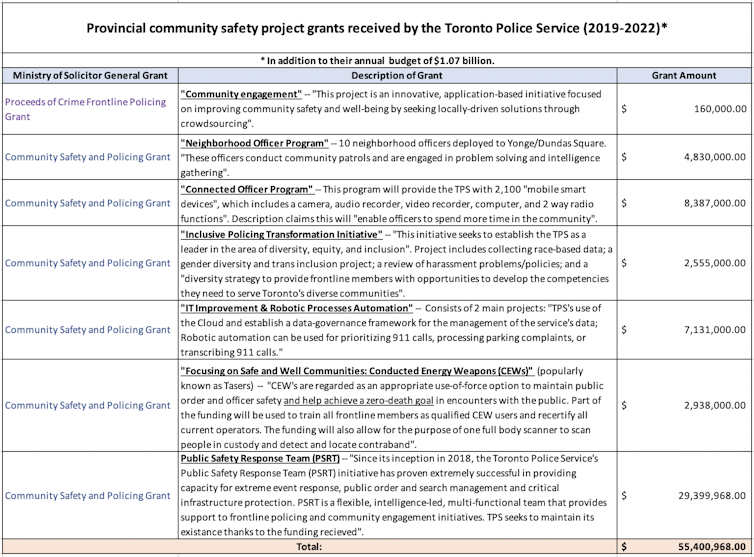Canada News
99% of Ontario’s funding for community safety and well-being pads police budgets

Of this $200 million, 99 per cent ($199 million) goes directly to police forces on top of their annual budgets. City service providers and community organizations doing preventive work receive less than one per cent ($1.6 million). (File photo: ev/Unsplash)
In the aftermath of Regis Korchinski-Paquet’s tragic death, Torontonians are asking their city councillors to defund the Toronto Police Service. But city council isn’t the only place to begin defunding the police; there’s also Queen’s Park.
While Toronto police’s budget is $1.07 billion, Ontario’s Ministry of the Solicitor General has made available another $200 million over four years in grants to organizations across the province to support the provincial Community Safety and Well-being (CSWB) Strategy.
Of this $200 million, 99 per cent ($199 million) goes directly to police forces on top of their annual budgets. City service providers and community organizations doing preventive work receive less than one per cent ($1.6 million).


Data: Ministry of the Solicitor General
Rhetoric vs. reality
The province’s policy recognizes that crime has systemic roots, prevention trumps enforcement and communities need other options when it comes to emergency response.
And yet, the spending patterns appear to contradict commitments to move away from “reactionary, incident-driven responses, refocusing investments towards the long-term benefits of social development and prevention.” The province’s CSWB strategy acknowledges that many challenges, such as mental health crises, are better managed through a “collaborative service delivery model that leverages the strengths of partners in the community,” instead of just the police.
That strategy is based on academic research that shows how investing in socio-economic development and addressing risk factors early can help reduce crime and violence. It is similar to public health planning, where evidence consistently shows that it is more effective and less expensive to address health issues before they result in a visit to the emergency room. But crime and violence command so much more political attention than the slow burn of poverty, structural violence and inequality.
The 99 per cent
In Toronto, the police received $55.4 million over four years (in addition to their billion-dollar budget). Only $360,775 was invested in organizations working to address the socio-economic roots of crime and violence in Toronto — that’s 0.7 per cent of the funding given to police.
To better understand what kinds of projects these provincial grants support in the Toronto police, I broke down the figures.


Data: Ministry of the Solicitor General
The province committed nearly $3 million to purchase conducted energy weapons, also known as Tasers, noting that they are “an appropriate use of force option” and that they aim to “achieve a zero-death goal in encounters with the public.” In fact, Tasers have been known to cause serious bodily harm and death. It’s also hard to understand how they are an investment in prevention or social development.
The $30 million Public Safety Response Team grant is similarly reaction-oriented, focusing on “extreme event response, public order and search management, and critical infrastructure protection.” While community and neighbourhood officers might play a preventive role, it is difficult to make a similar argument for mobile smart devices ($8.3 million) or IT improvement and robotic processes automation ($7.1 million).
Only six non-police organizations in Toronto dedicated to community safety and well-being received provincial funding, amounting to $360,775 over four years. Margaret’s Housing and Community Support Services received just under $70,000 even though it serves people who are at risk of coming into contact with the police due to poverty, mental health or addictions issues.
There are many organizations in the GTA working to address and prevent violence in their own communities with very little funding, like the Zero Gun Violence Movement, a coalition of over 40 community organizations addressing socio-economic and structural causes of violence. City programs like FOCUS Toronto have significantly reduced reliance on police, but need well funded non-police services to succeed.
The Ministry of the Solicitor General did not answer directly when asked by e-mail if the province’s spending on the police reflected its aspirations for community safety. But it did say that it “encourages collaboration between police services and community organizations in the delivery of community safety initiatives.”
Encouraging collaboration is one thing. Actually funding it is another.
The fact that so little funding is available for non-police service providers is even more troubling because the new Police Services Act requires municipalities to design, implement (and fund) CSWB plans. Providing so much additional money to police and so little to other safety and well-being organizations means enforcement will overshadow prevention.
Providing $200 million over four years is not a huge amount when spread across Ontario, but it is also not insignificant — especially considering the shoestring budgets available to organizations doing vital work to address the socio-economic determinants of safety.
Defunding as reinvestment
At the core of calls to defund the police is a desire to reinvest in communities in ways that reduce our reliance on police. As police themselves often remind us, they are not social workers and the majority of the issues they deal with are not criminal in nature.
Provincial cuts to municipal budgets are expected to cost the City of Toronto about $178 million per year, which means the city has far fewer resources available to municipal investments in prevention and social development work. The Social Development, Finance and Administration program, where Toronto’s CSWB Unit is located, experienced a 30 per cent reduction in funding from 2019 to 2020.
Social services are overstretched, and there is a real discussion to be had about the contributions of other provincial ministries in funding preventive work. But as it stands, the Ministry of the Solicitor General has over $200 million available for safety and well-being initiatives, and $199 million of that is going to police forces that are already very well funded.
Defunding the police is a creative proposal. It asks how we can redirect existing money to fight the causes of harm in our society. The province already has a policy framework to guide reinvestment and some money to make it happen — in theory, things could move quickly. So write to your city councillor, but don’t forget about your member of the provincial parliament.![]()
![]()
Claire Wilmot, PhD researcher, Department of gender studies, London School of Economics and Political Science
This article is republished from The Conversation under a Creative Commons license. Read the original article.





















